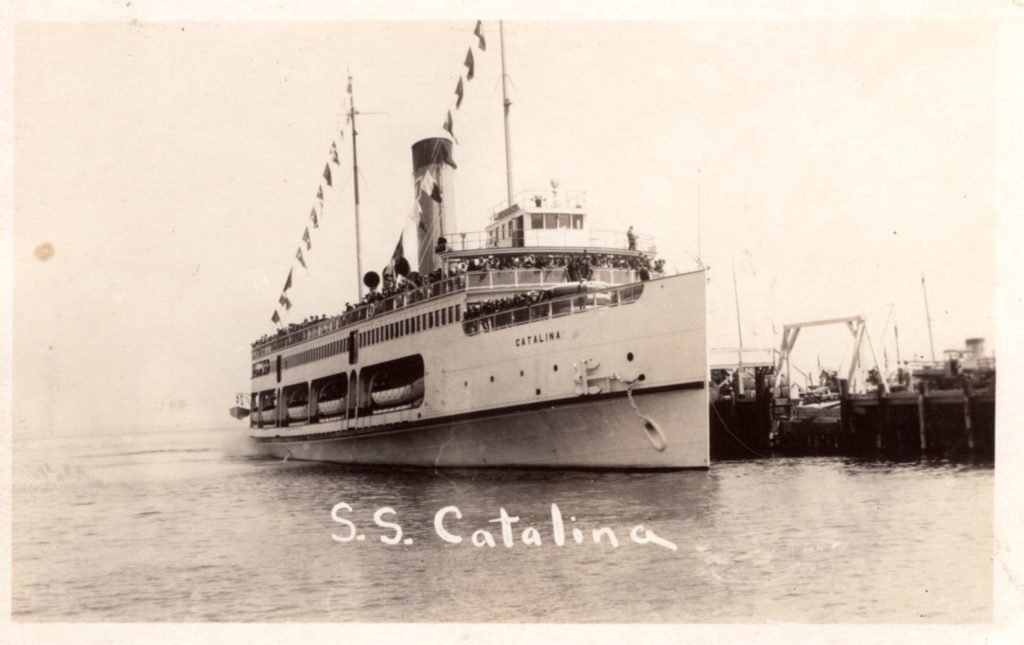William Wrigley Jr’s brand new “Million Dollar” ship, S.S. Catalina, left Los Angeles (Wilmington Harbor) bound for Avalon, Catalina Island, California on June 30, 1924, for her maiden voyage. This 20-mile trip would be repeated 9,807 times over her fifty-one years of service.
S.S. Catalina was built in record time (only five months) by the Los Angeles Shipbuilding and Drydock Company and would become one of the most remarkable vessels of its time! During her career, she carried 25-million people, more than any other ocean-going ship in history! During World War II she served as a U.S. Army Transport (FS-99) ferrying 820,199 men to various locations around the San Francisco Bay. After the war she returned to Wilmington Harbor.
Although Catalina was built to last, there was one problem at the beginning that caused problems for her crew. This beautiful new steam ship was fitted with anchor hawse pipes (anchor chain holes) far too close to the waterline. As a result, as she sped along, at up to 15.5 knots, through the some times choppy waters of the San Pedro Channel, water would be scooped up past the anchors and into the forecastle. This design flaw was quickly recognized and was soon corrected by moving the hawse pipes up to the main deck about a year after her maiden voyage.
For those of us who collect maritime postcards, this became an opportunity to look for and find the two different views of the ship. Generally, the older postcards, showing the ship with her original configuration, sell for more money and are less often found.

This card (left) is an artist’s rendition of S.S. Catalina published by the Wrigley Company while she was under construction. Notice that the artist has placed the anchors very high as opposed to their very low position when delivered.
The second postcard (below) shows the position of the port hawse pipe as S.S. Catalina began service in 1924. Also notice that her port anchor was placed on her main deck just below where her corrected anchor hawse pipe will eventually be located. ANZO Real Photo Postcard 1922-1926.


The third card shows a clear view of the starboard side of S.S. Catalina showing the original anchor position near the water line. Postcard published by the California Greetings and Post Card Company, Los Angeles (30421N).

The last card shows a view of S.S. Catalina’s starboard side with her anchor hawse pipe in the corrected position above the main deck.
The Wrigley family sold their steamship line to Charlie Stillwell who operated the S.S. Catalina under the banner of M.G.R.S. (Maynard, Gates, Rosenberg, Stillwell) Company, Inc. beginning with the 1960 season. This 1960 Western Publishing & Novelty Company postcard shows the ship after being sold to the Stillwell group and undergoing changes in its color scheme later followed by other changes including the removal of her masts.
Labor problems caused more and more problems in the operation of S.S. Catalina, and unfortunately, she did not survive. On September 14, 1975, Captain Lloyd Fredgren, rang down “Finished with Engines” for the final time on her Catalina Island service.
S.S. Catalina eventually ended up at Ensenada’s Harbor in Baja California where after years of ownership arguments, vandalism, and lack of attention, she literally rusted away before being scrapped. Lost forever, to the millions who traveled on “The Great White Steamer.”
It’s a shame that this historic ship was allowed to rust away before being scrapped.
Great article. Thank you.
Interesting article, but note that “port” is the left side of a ship and “starboard” is the right side as viewed from on board the ship!!